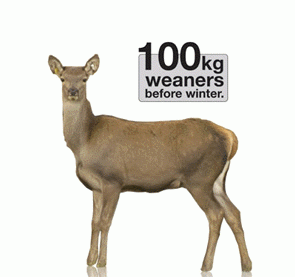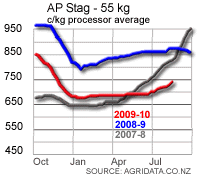
Issues of venison finishing, intensive integrated land use, and supply chain partnerships, were discussed at David and Hilary Ward's 425ha Radfield Farm at Fairton Ashburton, last week.
One hundred and fifty farmers and industry people visited this intensively irrigated cropping farm on the open day. It has integrated venison and lamb finishing into its cropping regime.
On medium to light free draining soils the Wards have for 15 years run a no tillage operation that has improved the organic matter in the soil, and through this, the water holding capacity.
Ward said that while there was little advantage in direct costs with this form of tillage, there were huge advantages in timing of crop sowing, and improvements in soil health.
The Wards normally winter the deer on a brassica crop of either kale, swedes or fodder beet with yields of 10-15,000 kg DM per hectare. They have found fodder beet a preferred variety for finishing, with the weaners adjusting to the different diet quicker than the other brassicas. However with lower protein levels, supplementation with pea vine hay grown on the place was a must.
They carry stock of 584 mixed sex hybrid weaners and 164 red weaner stags which were purchased in April at 65kg for $323 per head.
Intially in the autumn, they utilised white clover and Italian ryegrass pastures. This year however, no winter feed was grown as the deer were fed on some sprouted barley, pea vine, and Italian ryegrass. They were viewed looking very healthy, and weights recorded showed they had achieved growth rates of 204-250 gms/day since purchase, and were seen on their spring Italian diet, pre slaughter.
The 60ha they wintered on will soon be reduced to 30ha as animals get harvested for venison, and alternative crops fill the rotation.
This intensive integrated system will require all animals to be finished by 20th October when paddocks will be shut for seed production.
They target 55-60 kg CWT average for their animals to coincide with the peak spring schedules, and this operation topped other alternative land uses in gross margins, including cow wintering on this type of land.
Returns of 30c/kg of DM was earned by this enterprise in just seven months, eclipsing the 26c/kg DM earned from cow wintering and 11.c/kgDM from a 160% breeding ewe enterprise.
Many at this field day felt that, as too much land had already been lost to the dairy expansion, these sort of more-than-competitive outcomes should be more widely known.
The field day then reconvened in the Fairton Hall, where the new Chairman of Deer Industry NZ, Andy MacFarlane addressed the meeting, explaining his vision for the industry.
This was followed by an entertaining debate which focussed on the future of deer finishing; "Foothills or Plains". Good performance was illustrated by both areas of finishing by top operators that will allow animals to reach target weights in time for the chilled market.
There was also intense discussion about how to get long term supply of weaners from breeders, that gives a win-win outcome with finishers, and also meets the industry's objectives.
This was an excellent fielday showing what's possible, and should rekindle enthusiasm in the deer industry, showing that well-run intensive integrated operations are very profitable and can more than hold its own compared with dairying.
We welcome your comments below. If you are not already registered, please register to comment.
Remember we welcome robust, respectful and insightful debate. We don't welcome abusive or defamatory comments and will de-register those repeatedly making such comments. Our current comment policy is here.